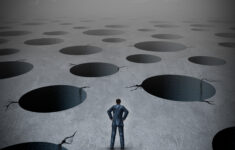Chairs provide great support during long meetings, but they may also be holding us back.
Standing during meetings boosts the excitement around creative group processes and reduces people’s tendencies to defend their turf, according to a new Washington University in St. Louis study that used wearable sensors to measure participants’ activity levels.
“Organizations should design office spaces that facilitate non-sedentary work,” says Andrew Knight, PhD, assistant professor of organizational behavior at Olin Business School.
Knight teamed with Markus Baer, PhD, associate professor of organizational behavior at Olin, on a new paper, “Get Up, Stand Up: The Effects of a Non-Sedentary Workspace on Information Elaboration and Group Performance,” published online June 12 in the journal Social Psychological and Personality Science.
The paper will be featured in an upcoming issue of Praxis, Olin’s journal of research that impacts business.
Removing chairs could be a low-cost way to redesign an office space while also tackling the health effects of sitting in one place for too long, Knight says, citing mounting evidence that a sedentary lifestyle is bad for people’s health.
“Our study shows that even a small tweak to a physical space can alter how people work with one another,” he says.
Knight became interested in exploring the group dynamics of standing meetings when the university was in the process of constructing Knight and Bauer Halls, the two new business buildings on the Danforth Campus.
“Markus and I were particularly interested in the role of a sedentary workspace because standing desks were a new option that was available to faculty members for outfitting their offices,” he says. “We wondered how this type of arrangement would play out for people working together in a group to achieve a collective goal.”
So Knight and Baer designed a study that asked participants to work together in teams for 30 minutes to develop and record a university recruitment video. The teams worked in rooms that either had chairs arranged around a table or with no chairs at all. After making the videos, research assistants rated how the team worked together and the quality of the videos, while the participants rated how territorial their team members were in the group process.
The participants wore small sensors around their wrists to measure “physiological arousal” — the way people’s bodies react when they get excited. When a person’s arousal system becomes activated, sweat glands around the feet and hands release bursts of moisture. The sensors pass a small current of electricity through the skin to measure these moisture bursts.
Knight and Baer found that the teams who stood had greater physiological arousal and were less territorial about ideas than those in the seated arrangement. Members of the standing groups reported that their team members were less protective of their ideas. This reduced territoriality, led to more information sharing and higher quality videos.
“Seeing that the physical space in which a group works can alter how people think about their work and how they relate with one another was very exciting,” Knight says.
The new study is a novel contribution to the relatively new study of organizational behavior and office design as it includes wearable sensors. “Wearable technology like FitBit and Google Glass is becoming more popular for consumers but is still relatively rare in this kind of research,” Knight says. “We think that the future holds great promise for integrating wearable technology into research; our study is one example of how doing so can enrich a study.”
Knight encourages organizations to experiment with their office spaces. Removing chairs and adding whiteboards are low-cost options that encourage brainstorming and collaboration. In his own office, Knight uses an adjustable-height desk so he can sit or stand and tries to minimize time spent seated in meetings. He is now experimenting with walking meetings too.
“We’ve really just scratched the surface on linking group dynamics research with the physical space,” Knight says.
He and colleagues hope to help organizations experiment with different room designs out of the lab and in the real world. “Working in the field, with real organizations, will help us to examine the longer-term effects of physical space manipulations.”
Source: Washington University in St. Louis





















 Smoke, Coverage Issues Cloud Wildfire Forecast: $35-$45B Losses Insured
Smoke, Coverage Issues Cloud Wildfire Forecast: $35-$45B Losses Insured  Insured Losses From Los Angeles Wildfires Rising: $8B to $20B
Insured Losses From Los Angeles Wildfires Rising: $8B to $20B  Will California’s FAIR Plan Have Enough Cash for Its Wildfire Claims?
Will California’s FAIR Plan Have Enough Cash for Its Wildfire Claims?  Leading Insurance Innovation in the AI Age (Part 1: Culture)
Leading Insurance Innovation in the AI Age (Part 1: Culture) 









